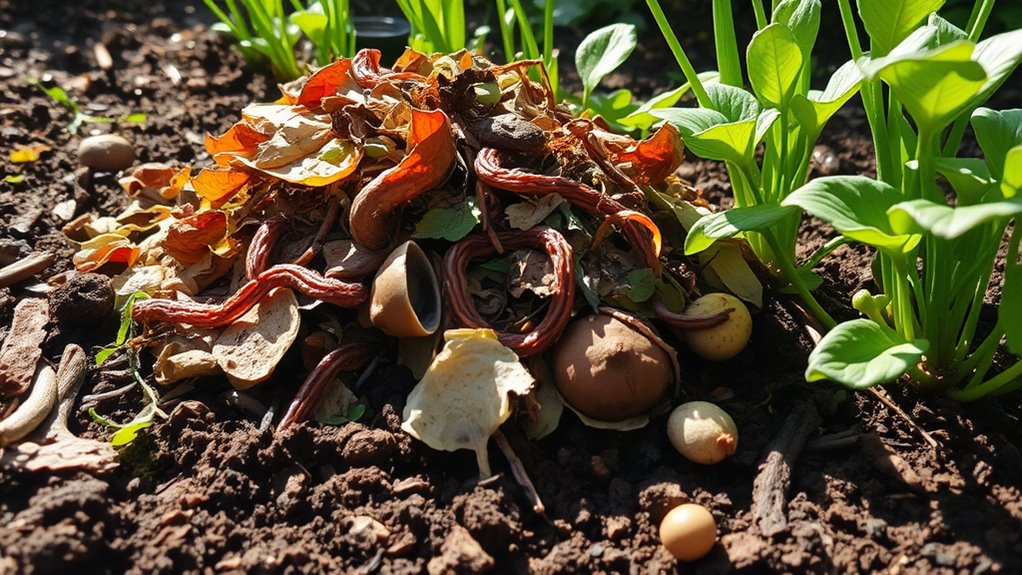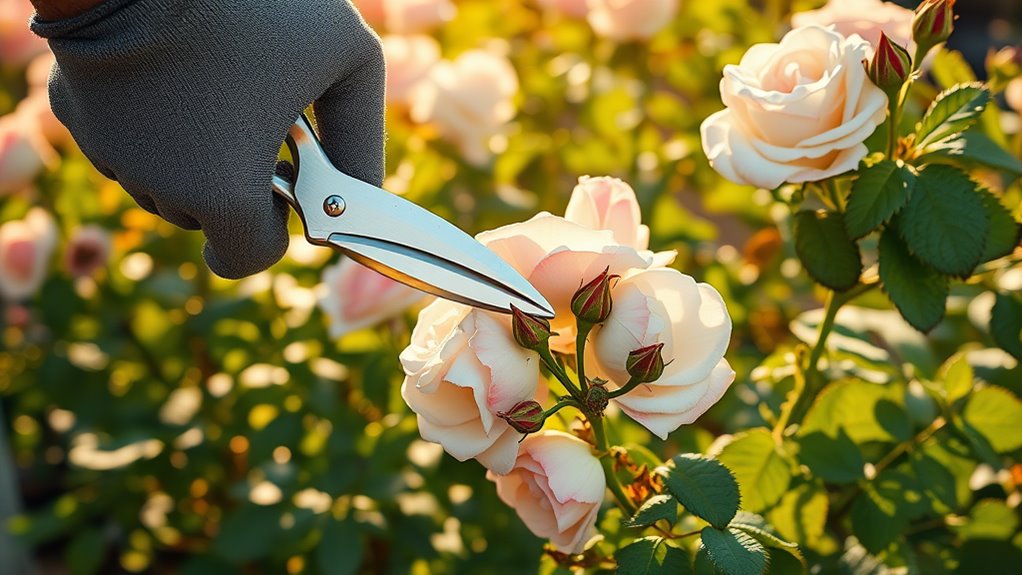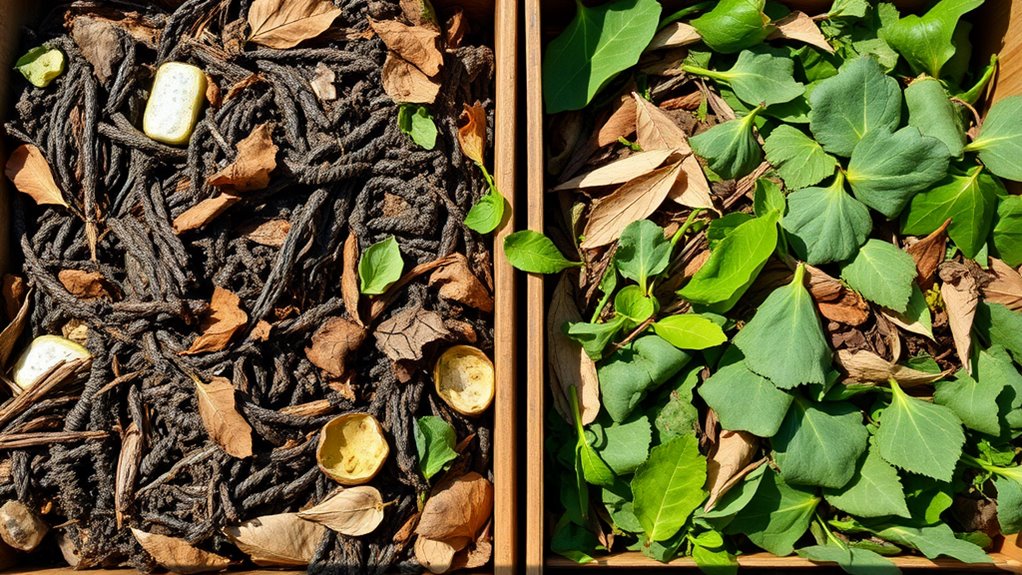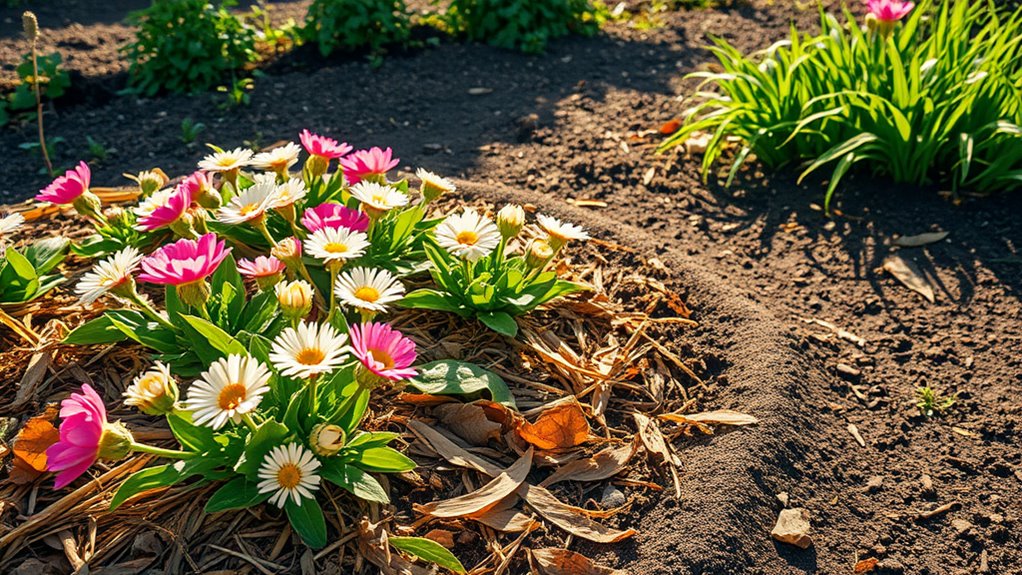The Lazy Way to Compost That Still Gets Results
You don’t have to slave over compost to get amazing results—just gather simple greens like kitchen scraps for nitrogen and browns like dried leaves for carbon. Set up an easy bin in a convenient spot, turn it every few weeks for aeration, and keep it moist like a wrung-out sponge to avoid odors. This lazy method still yields nutrient-rich soil for your garden, so you’ll want to check out more tips to boost your eco-friendly setup.
Key Takeaways
- Lazy composting minimizes effort by using kitchen scraps and yard waste to create nutrient-rich soil without daily maintenance.
- Set up a simple bin in an easy-to-access spot and turn the pile every 2-4 weeks for effective aeration.
- Balance green materials like vegetable scraps with browns like dried leaves to prevent odors and promote decomposition.
- Maintain moisture by checking weekly and keeping the pile as damp as a wrung-out sponge for optimal results.
- Use finished compost to improve garden soil, enhancing plant growth and moisture retention with minimal ongoing work.
Why Choose Lazy Composting
Because traditional composting can demand a lot of effort, you’ll appreciate lazy composting as a simple alternative that saves time while turning kitchen scraps into rich soil. With this method, you can produce nutrient-rich compost to enhance your home garden’s health and sustainability.
Low-effort composting minimizes daily maintenance, letting you focus on other tasks while your scraps break down naturally. You’ll reduce waste and boost garden health without the hassle of turning piles or monitoring moisture.
It’s ideal for busy lifestyles, offering practical sustainability that fits seamlessly into your routine. By choosing this method, you promote eco-friendly habits effortlessly, yielding nutrient-rich soil for thriving plants.
Additionally, lazy composting effectively incorporates kitchen scraps and garden waste to enhance soil health and promote sustainable practices.
Simple Materials for Your Pile
You’ll love how easy it’s to build your compost pile with green materials like grass clippings, brown materials such as dried leaves, and everyday kitchen scraps.
These simple ingredients balance your pile and break down naturally without much effort from you.
Now, let’s look at how you can source and add them to get started.
By using kitchen scraps, you can foster healthier plants in your garden.
Incorporating these elements allows busy beginners to produce nutrient-rich compost with very little daily maintenance.
Green Materials
Green materials fuel your compost pile by supplying nitrogen for efficient breakdown.
You’ll find them in everyday kitchen waste like fruit and vegetable scraps, coffee grounds, and tea bags—these are nitrogen-rich and easy to gather. Fresh grass clippings from your lawn add a boost too.
For a lazy approach, just toss them in as you create them, keeping your pile balanced and active. This simple habit speeds up decomposition without extra effort, turning your scraps into nutrient-rich soil effortlessly.
Stay consistent, and you’ll see results in no time.
Brown Materials
Brown materials balance your compost pile by supplying carbon, which teams up with green materials for efficient breakdown.
They’re the dry, easy-to-gather elements that keep things airy and odor-free, making your lazy composting effort more effective without much hassle.
- Snag fallen leaves from your yard; they’re plentiful and add bulk quickly.
- Shred newspaper or paper; it’s a no-fuss way to recycle and balance moisture.
- Use straw or hay; these lightweight options layer easily for better aeration.
- Grab cardboard scraps; tear them up to create space in your pile effortlessly.
Kitchen Scraps
Kitchen scraps are the everyday heroes of your compost pile, providing nutrient-rich nitrogen that speeds up decomposition with little effort.
You’ll love how easy it’s to use items like fruit peels, veggie trimmings, and coffee grounds—just toss them straight in. This keeps your pile moist and active, breaking down faster without daily tending.
For lazy success, collect scraps in a countertop bin and add them weekly, balancing with browns to avoid odors. Skip meats or oils to deter pests, and you’ll turn kitchen waste into nutrient-packed soil in months, effortlessly boosting your garden.
Setting up With Minimal Effort
You’ll kick off your setup by choosing a simple bin that keeps things straightforward. For small spaces, consider using a compact bin to maximize efficiency.
Next, gather the basic supplies you need without overcomplicating the process.
Then, find an easy location that makes your composting spot accessible and hassle-free.
This approach integrates into an easy composting routine that produces black gold soil for your garden.
Choose Simple Bin
A simple bin is your go-to option for effortless composting. It’s straightforward, requiring no complex setup, so you can start turning waste into nutrient-rich soil without overwhelming effort. This method keeps things low-maintenance and fits seamlessly into your lazy routine.
-
Pick a ready-made bin****: Grab a basic plastic or wooden one from a store; it’s affordable and instantly usable.
-
Size it right: Choose something small enough for your space but large enough for regular additions, avoiding overcomplication.
-
Position for ease: Place it near your kitchen or garden for quick access, minimizing trips.
-
Focus on simplicity: Select a bin with ventilation to prevent odors, ensuring it works without constant monitoring.
Gather Basic Supplies
Once you’ve chosen your simple bin, it’s time to gather a few essential supplies that make setup straightforward and low-effort.
You’ll need a small kitchen bucket for collecting scraps, which keeps things tidy without extra trips.
Grab some brown materials like shredded newspaper or dried leaves to balance greens and speed up decomposition.
Don’t forget basic gloves for handling waste—they’re cheap and protect your hands.
A simple spray bottle for moisture control rounds it out, ensuring your pile stays just right.
These items are easy to source, so you’re composting in no time with minimal fuss.
Find Easy Location
With your supplies gathered, consider a convenient spot for your compost bin to keep things simple.
Choosing the right location minimizes effort while maximizing results, so you’re not hauling waste far or dealing with messes. It ensures easy access and better decomposition.
-
Stay close to home: Pick a spot near your kitchen door for quick additions.
-
Seek shade: Opt for a partially shaded area to maintain moisture without extra work.
-
Ensure stability: Choose level ground to prevent the bin from tipping over.
-
Think accessibility: Select a place that’s reachable year-round, avoiding muddy or snowy spots.
Maintaining the Compost Easily
Maintaining your compost pile doesn’t have to be a hassle if you follow a few key habits. You’ll keep things simple by turning it occasionally, checking moisture levels, and balancing materials without overthinking. This lazy approach ensures your pile thrives with minimal effort.
| Habit | How to Do It | Benefit |
|---|---|---|
| Turn the pile | Every 2-4 weeks with a fork | Improves aeration and breakdown |
| Monitor moisture | Keep it damp like a wrung sponge | Prevents odors and maintains activity |
| Balance materials | Add greens and browns as needed | Promotes efficient decomposition |
Quick Tips for Success
To ensure your lazy composting thrives, here’s how you can apply a few quick tips that boost efficiency without extra work—keep them simple and effective for the best results.
These tips help you maintain a smooth operation with minimal fuss.
-
Keep moisture balanced: Check your pile weekly and add water if it’s too dry, avoiding sogginess for optimal breakdown.
-
Mix materials wisely: Alternate greens (like vegetable scraps) with browns (like dried leaves) to prevent odors and promote even decomposition.
-
Aerate lightly: Give the pile a quick turn every few weeks to introduce air without disrupting your lazy routine.
-
Use basic protection: Cover your compost to shield it from rain, helping maintain consistent conditions effortlessly.
Additionally, addressing common composting issues will help you quickly revive your pile if problems arise, ensuring you still achieve rich, healthy soil.
Using Your Finished Compost
Once your compost pile has fully decomposed into nutrient-rich soil, you’ll easily transform your garden by mixing it into the topsoil. For even richer results, try ingredient swaps to enhance the decomposition process and produce superior compost.
Start by spreading a 2-4 inch layer over beds, then till it in lightly to boost nutrients and water retention without overworking.
For lazy efficiency, use it as mulch around plants to suppress weeds and retain moisture.
You can also mix it into potting soil for seedlings, enhancing growth naturally.
By using your finished compost as mulch, you can unlock benefits like moisture retention and improved soil health.





